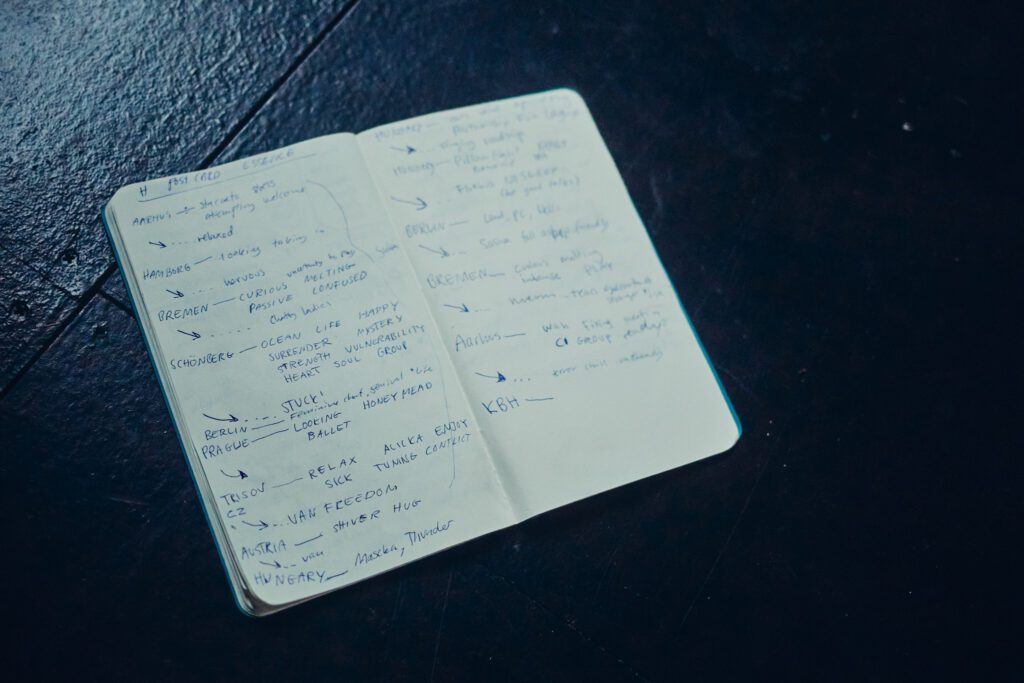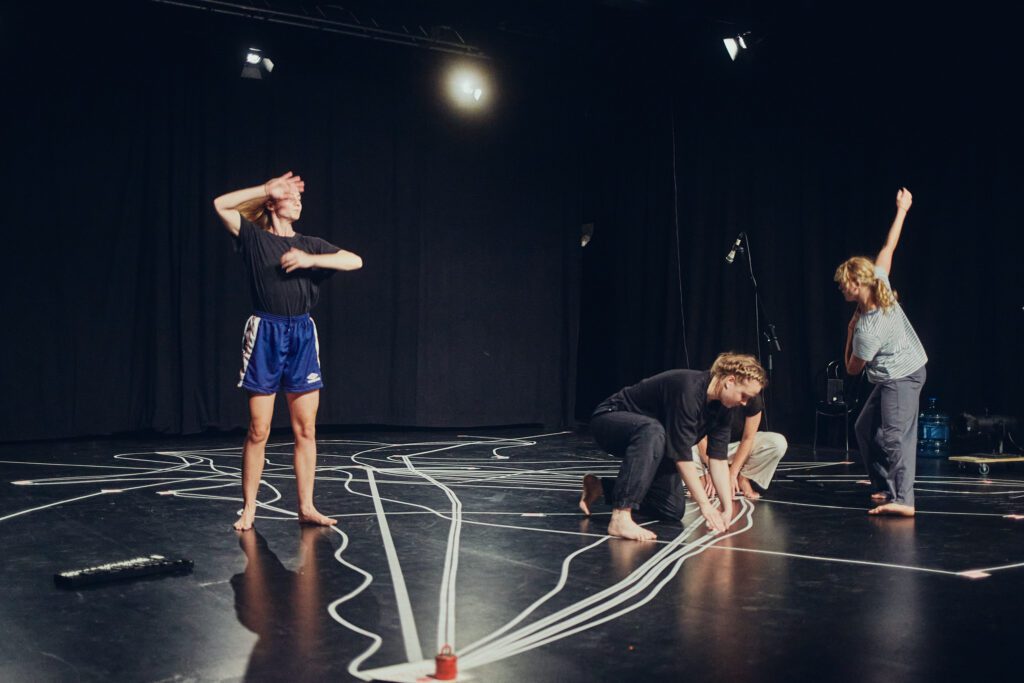How to arrive after landing was the name of the project that Šárka Benedová, Atul Giri, Helene Düring Kjær, Victoria Heggelund, and Martine Rubin Wollan worked on during their IN PROCESS residency at HAUT, curated together with RAS in Sandnes, Norway. This text is a part of the collaboration between HAUT and bastard.blog. A collaboration where they try to find new ways of documenting artistic research and work methods.
The worksharing of the performance How to arrive after landing took place on Sunday the 27th of August at Teatret Zeppelin, where the residency took place. It marked the first collaboration of Šárka Benedová, Atul Giri, Helene Düring Kjær, Victoria Heggelund, and Martine Rubin Wollan, coming from different backgrounds such as contemporary dance, music, sound design and textile. The project took its inspiration from a sentence that “the soul travels slower than the body”. During the residency, the group explored the discrepancy between going somewhere and actually arriving there with your body. They mapped their journeys, practised “observational listening”, and went swimming among other things that all informed the piece.

Even though they come from different disciplines, one thing all of their work and life has in common is a lot of travelling. In How to arrive after landing we were invited on a collective journey through precarious working conditions, individuality and collectivity, the mundane and the ecstatic and the impossibility of the word ‘here’.
*
In the foyer of the theatre, we are guided in by some lines on the floor marked up with tape as we step through a mind map of posters and notes on the walls. “Our journey to here and now – performed postcards,” one of the posters says.
Inside the theatre one of the performers is marking out lines on the floor going from one post-it to another. On the notes are names of places: Sandvika, Oslo, Bratislava, Vienna, India … Krrrrrrrr is the sound of the tape being unrolled, that becomes a soundscape in the space. One of the performers is dancing gently to the sound of the tape.
“Is this piece about travelling?” they ask the audience and each other.
Then they start recounting and reenacting their trips in the last year through movement and words. As they move from post-it to post-it, it becomes clear that the tape and post-its make up a psycho-geographical map of the places the members of the group have been and what they did there. Some of them quickly travel to other post-its, while others stay put for a while. One performer is commuting: walking back and forth between two post-its. A recording of rain starts playing. One of the performers starts singing, while they keep moving.

While I watch, I begin mapping my own trips in my head. I remember the loneliness and stress of jumping from place to place (and never ‘arriving’), but also the joy of discovering a new place. I remember the short trips – going back and forth to Croatia in 3 days… – and the long trips – spending 30 days in a small village in Bulgaria. I remember the buses, trains, planes and ferries. My thoughts are interrupted by an alarm from a phone on the floor (like the alarm you set to avoid falling asleep on a train and not getting off at the correct stop).
After the alarm, the performers meet in the same spot, on top of the post-it that marks Copenhagen. They lean against each other. They try to become one body, to negotiate a collective posture. They talk about weight, how to ground yourself.
One of the performers picks up a small weight from the floor and drops it in the open palms of one of the other performers. Their hands drop a bit as they catch it. Then they proceed to do the same thing to one of the other performers. Afterwards, they turn to the audience and hand the weight to us. We are instructed to drop the weight in the hands of the person next to us. The continuous dropping of the weight makes me think about pins dropped on maps.
The following part of the performance takes place in darkness. We can hear the sound of traffic. We can hear the sound of trolleys rolling on the pavement. I am transported once again. My body is back in Bulgaria, on a train station in the evening, having missed a train trying to figure out what all these signs in a foreign language are saying. The sound of my trolley on the tiles of the station as a question: Rrrrrrrrrrrrrrrr?
Smoke fills the space. Music begins to play. A song that I can’t figure out the words of, but it’s something about crossing each other’s paths maybe. I think about how travelling is both a condition for this work and a subject. An echo of the question at the beginning of the piece: “Is this piece about travelling?”. Maybe the work is not so much ‘about travelling’ as it is ‘performing travelling’.

I’m blinded by a light and transported back in the space. A performer drives a lamp around on a small dollie, pointing it at the audience. I squint my eyes. The light is blinding like cars driving by at night. One of the performers is getting kicked back and forth between two other performers, lying on their backs, their feet pushing the person back and forth, repeating the commute-movement earlier, but with a violent touch.
Then the piece becomes more collaborative again. A group of performers are carrying something invisible together. They are trying to figure out the size, the weight and the position of the thing they are carrying. “Here?” one of them tries. Another one puts their hands around the same space of air: “Here?”. They carry the invisible object. They hold the space for each other.

There is a mumbling feeling to How to arrive after landing. Like someone is trying to talk themselves through something or comfort themselves. When we’re lonely for a long time we start talking to ourselves. The piece feels like a bodily travel journal. There is connection and collaboration in the piece, but somehow there’s also an undertone of loneliness. The loneliness of being surrounded by a group of people, but still feeling alone. Or being somewhere but not being able to really take it in. How to arrive after landing feels like an exercise in being present in a space and on how to stay sane when you are in a perpetual state of transit. We are not offered any answers, but we are given questions, images, movement, sounds, exterior and interior journeys.
The group of performers has ended up again in the corner with the ‘Copenhagen post-it’. One of them is playing a note on a glockenspiel: “I think this one sounds like here“. The group agrees. The distinct bright sound of the glockenspiel fills up the space and ends the piece. The notification from a GPS, the alarm waking you up on a train, the tone before a boarding call in an airport.
You have arrived at your destination. /?
